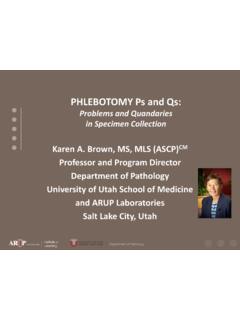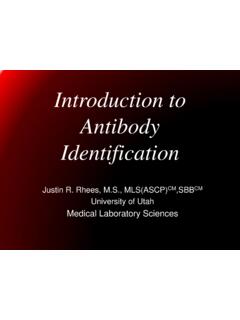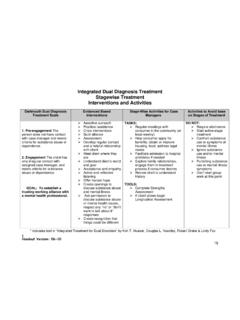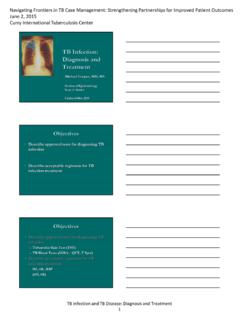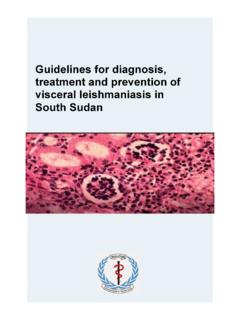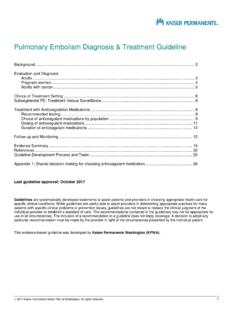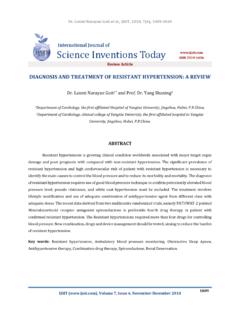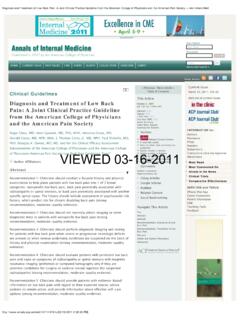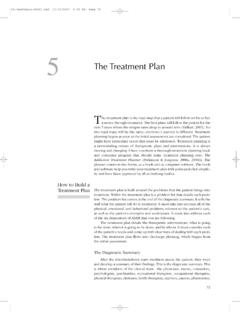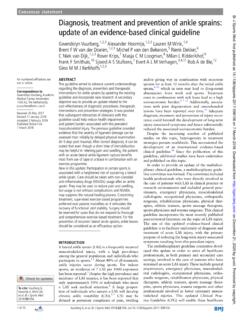Transcription of Kidney Stones: Diagnosis, Treatment, & Future Prevention
1 Kidney stones : diagnosis , treatment , & Future Prevention Jessica Corean, MD PGY 3 Anatomic and Clinical Pathology Resident University of Utah CME statement The University of Utah School of Medicine adheres to ACCME Standards regarding industry support of continuing medical education. Speakers are also expected to openly disclose intent to discuss any off-label, experimental, or investigational use of drugs, devices, or equipment in their presentations. The speaker has nothing to disclose. Learning Objectives the clinical presentation, laboratory, and radiographic findings of an individual affected by a Kidney stone. 3 composition types of Kidney stones and their clinical management. spontaneous and familial risk factors for Kidney stone development. Outline Case-based Approach: diagnosis of a Kidney Stone Epidemiology Pathogenesis Risk Factors Management Further Work-up Prevention Complications Case #1: 38 year old male Flank pain Acute, colicky Radiating to pelvis and genitalia Nausea and vomiting Urinary urgency, frequency, and dysuria This has happened once Differential diagnosis Urinary tract infection Musculoskeletal pain Groin hernia Acute pyelonephritis Prostatitis Women: Ectopic Pregnancy Ovarian torsion Ovarian cyst rupture Indications for testing: Flank pain, Nausea & vomiting, and/or symptoms of a stone Order.
2 Urinalysis Hematuria Imaging Strain urine and stone analysis If second stone, consider 24 hour urine Emergency Department Work-Up Complete blood count Comprehensive metabolic panel Urinalysis Imaging CBC Normal Values for Adult Male RBC M/uL WBC Hgb 14-18 g/dL Hct 40-50% MCV 78-98 fL MCH 27-35pg MCHC 31-37% Neutrophils 50-81% Bands 1-5% Lymphocytes 14-44% Monocytes 2-6% Eosinophils 1-5% Basophils 0-1% Comprehensive Metabolic Panel Glucose 65-100 mg/dL BUN 8-25 mg/dL Creatinine mg/dL EGFR >60 ml/ Sodium 133-146 mmol/L Potassium mmol/L Chloride 97-110 mmol/L Carbon dioxide 18-30 mmol/L Calcium mg/dL Protein, total g/dL Albumin g/dL Bilirubin, total mg/dL Alkaline phosphatase 30-132 U/L AST 5-35 U/L ALT 7-56 U/L UA Findings Hematuria, microscopic Small amount of blood in urine Still yellow in color Single, most discriminating predictor of Kidney stone if patient presents with unilateral flank pain Present in 95% of patients on Day #1 Present in 65-68% of patients on Day #3 or #4 Kidney Anatomy Imaging Non-contrast helical CT More sensitive (88%) Radiation exposure, cumulative Ultrasonography At bedside (54-57%) No radiation Epidemiology 1-5/1000 incidence Approximately 1/11 affected in lifetime Increased from in 1970s to in 2000s Peak incidence in 20s Caucasian men Male > Female (2-3:1) Geography: Hotter and drier climates Pathogenesis Theory #1 Normally soluble material supersaturates within the urine and begins process of crystal formation.
3 Becomes anchored at damaged epithelial cells. Initiated in renal medullary then extruded into renal papilla. Acts as a nidus for further deposition. Pathogenesis Theory #2 Risk Factors Urine composition Prior Kidney stones Family history of Kidney stones Enhanced enteric oxalate absorption Frequent upper urinary tract infections Hypertension Low fluid intake Acidic urine Management and treatment Conservative Management Hydration Pain management Alpha blockers Strain/filter urine Aggressive Management Extracorpreal shock wave lithotripsy Ureterorendoscopic manipulation Open or laparoscopic surgery Decompression Ureteral stent Nephrostomy tube Aggressive Management Further Work-up Chemistry panel If serum calcium high-normal, then test parathyroid hormone concentration Stone analysis 24 hour urine Measured 2-3 times Wait 1-3 months after acute episode Stone analysis Collect information from the stone to establish cause(s) of stone formation and growth Identify possible underlying metabolic disorders Guide preventative therapy Types of stones Calcium stones Calcium oxalate (~80%) Calcium phosphate (~5-10%) Struvite stones (~10-15%) Magnesium ammonium phosphate hexahydrate Uric acid stones (~5-10%) Cystine stones (~1-2%) Combination Stone Analysis Testing Methods Chemical methods Destructive and need several mg of sample Cannot distinguish mineral constituents (with similar chemical composition)
4 Physical methods Need less sample Distinguish different minerals within one stone Physical methods X-ray diffraction (XRD) Fourier transform infrared spectroscopy Fourier Transform Infrared Spectroscopy into a powder beam passes through powder bonds within powder absorb portion of radiation giving a unique spectra Spectrum ARUP Stone Analysis Calcium oxalate monohydrate Ca(COO) (Whewellite) ARUP 24 Hour urine collection Measure: Volume pH Calcium Uric acid Citrate Oxalate Sodium Creatinine What is a supersaturation profile? Urine frequently supersaturated, favoring precipitation of crystals Balanced by crystallization inhibitors: ions (citrate) and macromolecules Measure ion concentration Computer program can calculate theoretical supersaturation risk with respect to specific crystalline phases Case Wrap-Up and Prevention All stones : maintain urine volume > Our patient had a calcium oxalate stone Recommendations: Reduce soft drink intake Thiazide diuretics Citrate pharmacotherapy (lower urinary citrate) Reduce sodium and animal protein Limit oxalate and eat more dairy (if oxalate high) Complications Can lead to persistent renal obstruction Permanent renal damage or renal failure Case #2.
5 27 year old female Mild dysuria for a few weeks Mild flank pain, which has intensified over the last 24 hours Emergency Department Work-up: Complete Blood Count Complete Metabolic Panel Urinalysis with Culture Imaging Female Complete Blood Count RBC M/uL WBC Hgb 12-16 g/dL Hct 37-47% MCV 78-98 fL MCH 27-35pg MCHC 31-37% Neutrophils 50-81% Bands 1-5% Lymphocytes 14-44% Monocytes 2-6% Eosinophils 1-5% Basophils 0-1% Urinalysis findings: Struvite Microscopic hematuria Elevated: Leukocyte esterase White blood cells Bacteria Crystals Coffin lid appearance Typically in alkaline urine Imaging Very dramatic Can block entire renal calyces Spectrum ARUP Struvite ARUP Epidemiology Approximately 10-15% of Kidney stones Typically women (3:1) Higher rates of urinary tract infections Pathogenesis Formation occurs only when ammonia production increased and urine pH is elevated, by urease-producing organisms: Proteus or Klebsiella Risk Factors Urinary tract infections Female Neurogenic bladder Urinary diversion Management Most large staghorn calculi require surgical treatment Options: Medical therapy alone Open or laparoscopic surgery Percutaneous nephrolithotomy Shock-wave lithotripsy Prevention Metabolic evaluation Similar to other types of Kidney stone formers Treat underlying medical issue Urinary tract and/or Kidney infection Case #3: 7 year old girl Flank pain Abdominal pain Preliminary Work-up.
6 Complete Blood Count Complete Metabolic Panel Urinalysis with culture Imaging Child Complete Blood Count RBC M/uL WBC Hgb 10-14 g/dL Hct 30-42% MCV 78-98 fL MCH 27-35pg MCHC 31-37% Neutrophils 50-81% Bands 1-5% Lymphocytes 14-44% Monocytes 2-6% Eosinophils 1-5% Basophils 0-1% UA Findings Microscopic hematuria Crystals Hexagonal crystals Spectra ARUP Cystine ARUP Pediatric Kidney stones In a child or adolescent (<12 years old) with first stone, clinician should suspect cystinuria Epidemiology of Cystinuria Cystine stones represent 1-2% of total Kidney stones In children, up to 5% of total Kidney stones Cystinuria: Autosomal recessive Due to an inherited impairment of renal cystine transport Males more severely affected than females Pathogenesis diagnosis One or more of the following are required to diagnosis cystinuria: analysis showing cystine family history of cystinuria cystine crystals on urinalysis (about 25% of patients) Further Work-up Cyanide-nitroprusside screen Urinary cystine excretion (amino acid panel) Management & Prevention Acute management Prevention .
7 Increase fluid intake Reduce sodium and protein intake Urinary alkalization Medications Management Monitoring 24 hour urine evaluation Assess response (and adherence) to treatment Measure urine volume, cystine, pH, creatinine, sodium, and calcium Measure supersaturation risk of cystine Retention Questions type of Kidney stone is the most common? a)Calcium b)Uric acid c)Cystine d)Cholesterol of the following options outline conservative Prevention strategies? a)Surgery b)Alpha blocker medication c)Increase fluid intake d)Increase sodium and animal protein intake of the following is true? a)All adults should have a full metabolic work-up with their first Kidney stone. b)All children should have a full metabolic work-up with their first Kidney stone. c)Struvite stone formers do not need antibiotic treatment .
8 D) Kidney stones larger than 10mm usually pass spontaneously. References Coe F, Parks J, Asplin J. The pathogenesis and treatment of Kidney stones . New Eng J Med 1992;327:1141-1151 Daudon M, Marfisi C, Lacour B, Bader C. Investigation of urinary crystals by Fourier Transform Infrared Microscopy. Clin Chem 1991; 37 Jager P. Genetic versus environmental factors in renal stone disease. Curr opinn Nephrol Hyperten. 1996: 5342-46. Modlin M, Davies PJ. The composition of renal stones analyzed by infrared spectroscopy. S Afr Med J 1981; 7 Pichette V, Bonnardeaux A, Cardinal J, Houde M, Nolin L, Boucher A, Ouimet D. Ammonium Acid Urate Crystal Formation in Adult North American Stone-Formers. American Journal of Kidney Diseases 1997; 30, 2: 237-242. Vergauwe DA, Verbeeck RM, Oosterlinck W.
9 Analysis of urinary calculi. Acta Urol Belg. 1994 Jun; 62(2):5-13. Accessed June 20, 2017. Topics: Nephrolithiasis, Staghorn Calculi Management, Cystinuria.
